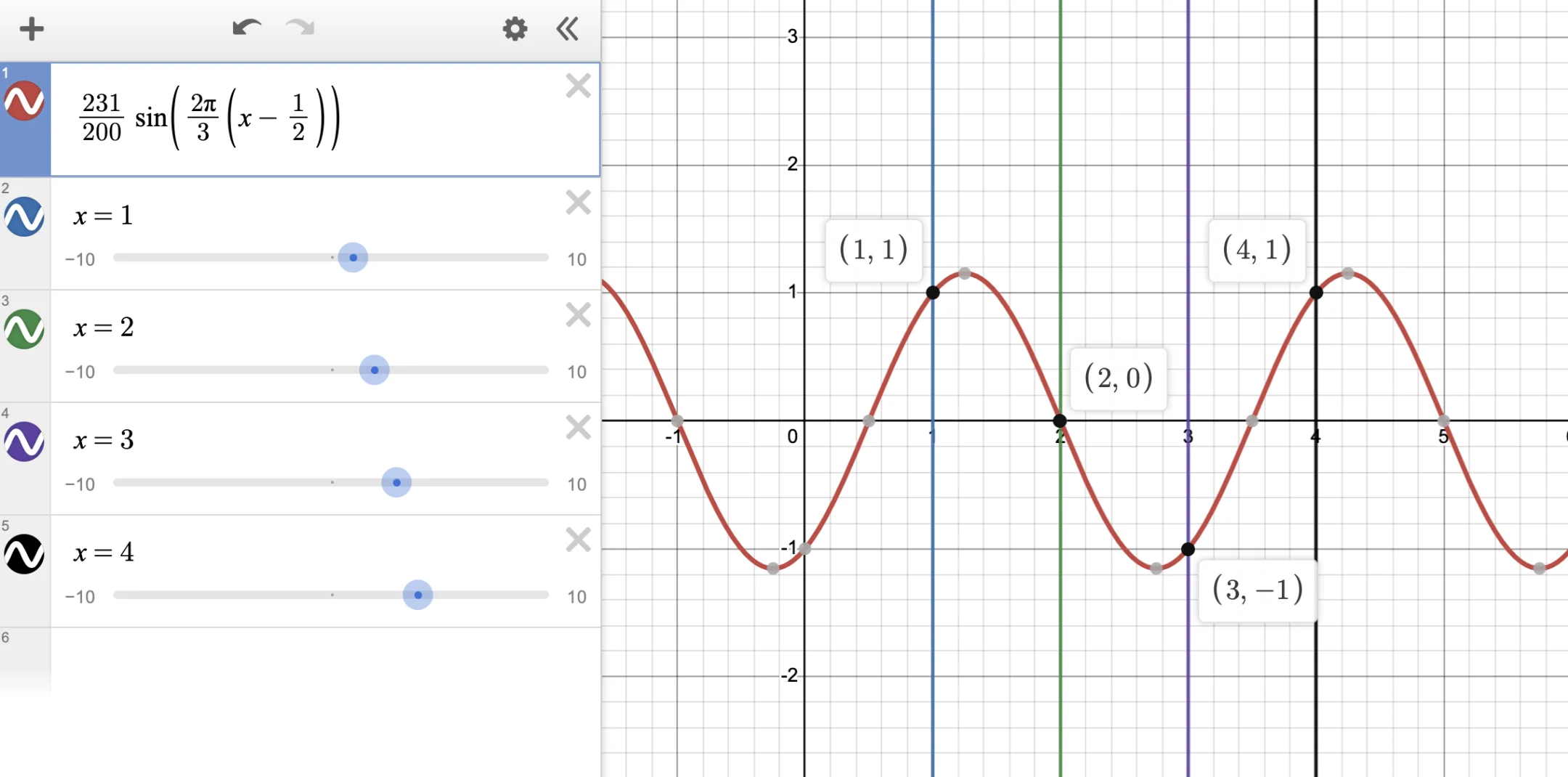Extending sequences into smooth functions using trignometric functions
Sequences sometimes extend to good examples of smooth functions with special properties e.g. interesting limsups and liminfs. For example, you may want construct a smooth function \(h(x)\) that continuously alternates between \(f(x)=x\) and \(g(x)=0\) so that it has a limsup of infinity and liminf of 0. By observation we could choose \(h(x)=\vert x \sin x\vert\). We would try to generalise this.
Remark: While we could use bump functions to produce a similar effect, it feels somewhat more elegant to use trignometric functions instead.
Definitions
We call a sequence \((a_n)\) \(k\)-periodic for some positive integer \(k\) if there exists smooth functions \(f_i : \mathbb{R} \to \mathbb{R}\) for \(i \in \{0, 1, \dots , k-1\}\) such that \(a_n = f_i (n) \text{ if } n \equiv i \; (\text{mod } k)\)
For example, \(a_n = (-1)^n\) is 2-periodic with \(f_0(x) = 1, f_1(x) = -1\).
2-periodic sequences
Proposition: If \((a_n)\) is 2-periodic, then there exists a smooth function \(f: \mathbb{R} \to \mathbb{R}\) such that for all \(n \in \mathbb{N}\), \(f(n) = a_n\)
Proof: Suppose \((a_n)\) 2-periodic with associated \(f_0\) and \(f_1\) functions. Let
\[f(x) = \cos^2 \bigg(\frac{\pi x}{2}\bigg) f_0(x) + \sin^2 \bigg(\frac{\pi x}{2}\bigg) f_1(x)\]We could see that if \(x\) is an even integer then \(f(x)=f_0(x)\) and if \(x\) is an odd integer then \(f(x) = f_1(x)\). Clearly \(f\) smooth as trignometric functions, \(f_0\) and \(f_1\) are smooth.
\[\blacksquare\]For example, we can extend \(a_n=(-1)^n\) to \(f(x) = \cos^2 (\frac{x \pi}{2}) - \sin^2 (\frac{x \pi}{2}) = \cos (\pi x)\).
k-periodic sequences
Proposition: If \((a_n)\) is k-periodic, then there exists a smooth function \(f: \mathbb{R} \to \mathbb{R}\) such that for all \(n \in \mathbb{N}\), \(f(n) = a_n\)
Proof: Suppose \((a_n)\) k-periodic with associated \(f_0, \dots , f_{k-1}\) functions. Let
\[g_j(x) = \sin \bigg(\frac{\pi}{k} (x-j) \bigg)\]for \(j \in \{0, 1, \dots k - 1\}\)
Note that for all \(j \in \{0, 1, \dots k - 1\}\) and integers \(i\), we have \(i \equiv j \; (\text{mod } k) \iff g_j(i) = 0\). Now we consider
\[f(x) = \sum_{i=0}^{k-1} \bigg[ \bigg(\prod_{j=0, j \neq i}^k \frac{g_j(x)}{g_j(i)} \bigg) f_i(x) \bigg]\]We can the verify that \(f\) is smooth and satisfies \(f(n) = a_n \; \forall n \in \mathbb{N}\). The idea is that each of the \(g_j\) acts a sieve and annihilates the necessary terms.
\[\blacksquare\]For example we can extend the sequence \(-1, 1, 0, -1, 1, 0, -1, \dots\) (assuming the sequence starts at \(0\)) which is 3-periodic with \(f_0(x) = -1, f_1(x) = 1, f_2(x) = 0\) into
\[\begin{align*} f(x) &= -\frac{\sin(\frac{\pi}{3}(x-1)) \sin(\frac{\pi}{3}(x-2)) }{\sin(\frac{\pi}{3}(0-1)) \sin(\frac{\pi}{3}(0-2))} \\ &\phantom{=}+\frac{\sin(\frac{\pi}{3}(x-0)) \sin(\frac{\pi}{3}(x-2)) }{\sin(\frac{\pi}{3}(1-0)) \sin(\frac{\pi}{3}(1-2))} \\ &= \frac{231}{200} \sin\bigg( \frac{2\pi}{3} (x- \frac{1}{2})\bigg) \end{align*}\]Here’s a graph of the function,

All maths posts